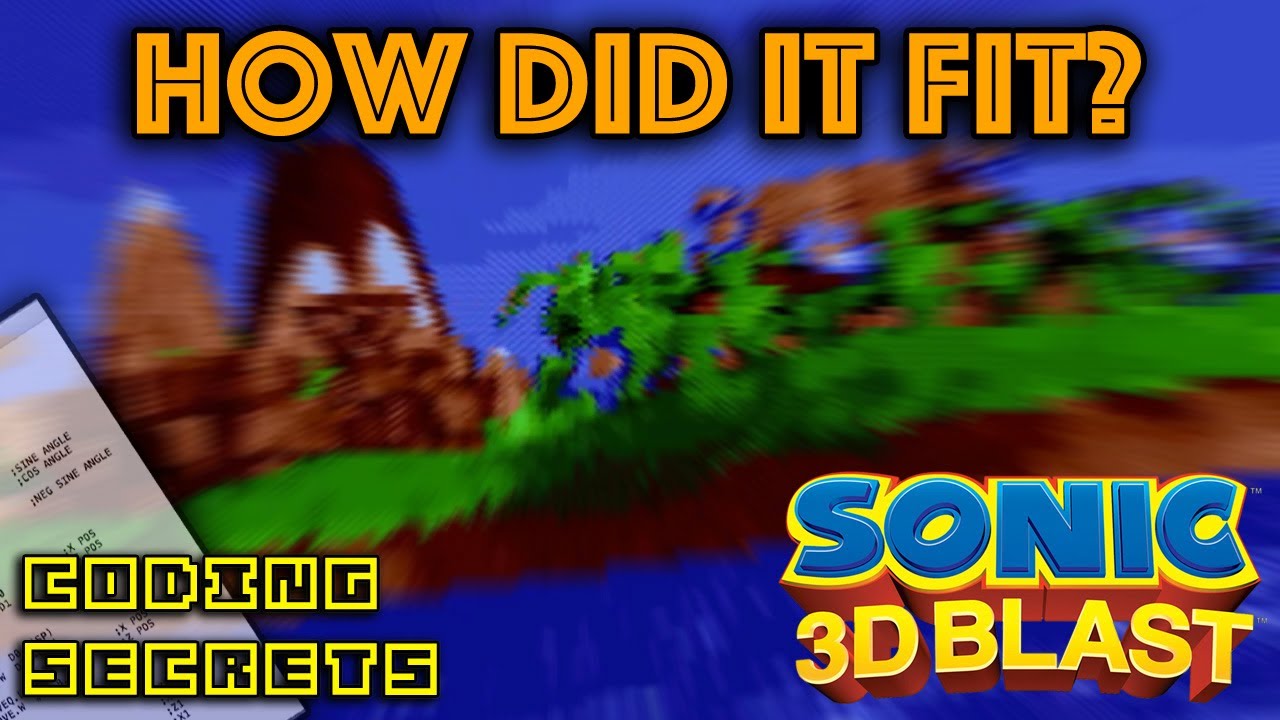Sonic 3d'S Intro Sequence Is Impossible To Fit On A Cartridge - Right?
Unleash Your Creative Genius with MuseMind: Your AI-Powered Content Creation Copilot. Try now! 🚀
Ladies and gentlemen, gamers and curious minds, the ever-curious have been scratching their heads in the comments, fervently asking, "How on earth did they manage to fit the cinematic marvel of Sonic 3D into that tiny cartridge?" Well, my friends, today we embark on a thrilling journey through the realms of video game wizardry, a tale of technology, innovation, and thinking outside the console.
🕹🎮
The Pixelated World of Sonic 3D
The world of gaming, especially in the 90s, was an arena of creative constraints and mind-boggling challenges. Sonic 3D was no exception, with its compact 4-megabyte cartridge. To truly understand the magic, we must first dive into the dimensions of this pixelated universe.
On the Sega Genesis, the standard screen size was a mere 320 pixels wide and 224 pixels tall. A quick calculation reveals that this compact canvas utilized approximately 72K of space. Now, Sonic 3D's cinematic intro ran for a mere 12.5 seconds, displayed at a silky-smooth 30 frames per second, consuming 72K per frame. By simple math, it would gulp down a staggering 27 megabytes of precious cartridge space. Alas, the Sonic cartridge had only 4 megabytes to spare, and most of that was claimed by the rest of the game. A conundrum, indeed.
But, as the great minds of gaming often do, they embarked on a quest for a solution, defying the odds, and pushing the boundaries of innovation.
Shrinking the Frame: Size Matters
Firstly, they decided to downsize. The cinematic animation was slightly shorter than a full-screen experience, a modest 200 pixels wide. Furthermore, it was presented in a humble 16-color palette. In this realm, each pixel took up only half a byte. The result? A leaner screen, weighing in at just 32K.
Moreover, they employed a little cinematic trickery. Instead of a full 30 frames per second, the intro operated at approximately 15 frames per second. But even with these changes, the animation was still a whopping 50 megabytes larger than the entire cartridge. The next step was compression - the magician's secret.
The Wizardry of RNC Compression
Here's where the real magic happened. The developers turned to something known as RNC compression. This wondrous method found the sweet spot between compression speed and final file size. Typically, it delivered a miraculous three-to-one compression ratio. However, there was a catch - it was too sluggish to decompress the entire screen any faster than a leisurely five frames per second.
With time running short and the need for drastic measures growing, they embarked on an even more extraordinary journey.
The Art of the Pixel
Behold, the biggest image they could work with, a mere 80 pixels tall, using the 256-pixel-wide screen mode. But how to make this look acceptable? The first trick involved horizontal interrupts, repeating lines of the image, essentially stretching it out to two and a half times its original size. These stretched lines then filled the screen once more.
The next challenge was the dithering effect. Dithering is a checkerboard pattern used to simulate half colors, but it disrupted the compression process. So, they opted for vertical lines, the easiest to compress, and offset every even horizontal line by a single pixel, creating the checkerboard effect they desired.
At this stage, they also made the image appear higher resolution than its humble 80 pixels. The shift from even to odd-numbered lines produced a subtle shift in the pattern. This ingenious alternation between these patterns at 60 frames per second resulted in a stunning array of colors, crafting a visually captivating image.
Revisiting the math, the once 80-pixel image had now shrunk to a mere 10K. Add in the RNC compression magic, and the total size hovered at around 3.5K. The final calculation gave them a size of approximately 660K, beautifully fitting within the designated space for the intro.
The surprise was real, my friends. The team had been saving their bag of tricks for just the right moment, dropping in the animation with only a few weeks to spare. Luckily, the gaming world embraced their audacious experiment with open arms, and the rest, as they say, is history.
🚀✨
So there you have it, the exhilarating tale of how Sonic 3D's cinematic wonder found a cozy spot within the confines of a minuscule cartridge. In the world of gaming, where imagination knows no bounds, these ingenious minds took the challenge head-on and emerged victorious, leaving us with a cinematic gem that still dazzles players today. The lesson here? Never underestimate the power of creativity, innovation, and a little bit of pixelated magic.

Related Recaps
- 2022 ICT Mentorship - Ends Series Part 3 of 4
- Convegno Un Mondo Positivo - Claudio Testa - 24 marzo 2023
- He struggled in the cold mud, tried to get up to run but failed
- What TO DO when dating a Japanese guy | DATING EXPECTATION from Native Japanese Perspective
- அரசுக்கு பதில் இந்த பாலை தனியாருக்கு கொடுத்தால் அதிக லாபம் வரும் - உற்பத்தியாளர்கள் அதிரடி